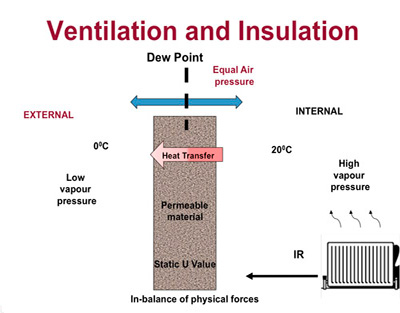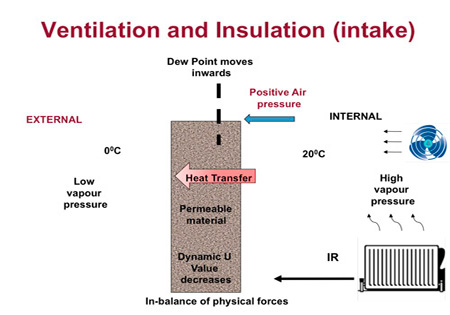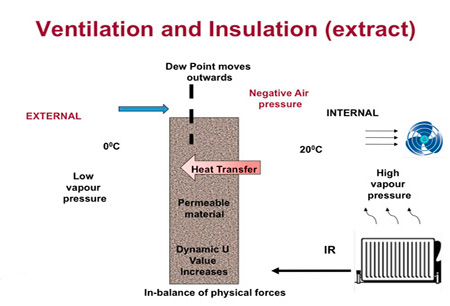Condensation and Mould Issues
Factors Affecting Condensation and Mould
In todays energy conscious environment, natural ventilation within homes is greatly reduced by the introduction of double glazing, draught excluders, fitted carpets (which prevent air movement up through suspended wooden floors) and, with the introduction of central heating and the removal of open fireplaces.
Houses have become effectively sealed boxes, keeping in any moisture produced and providing ideal conditions for condensation to occur.
Condensation occurs where moist warm air comes into contact with colder dryer air, or a surface, which is at a lower temperature.
Air contains water vapour in varying quantities; its capacity to do so is related to its temperature – warm air holds more moisture than cold air. When moist air comes into contact with either colder air or a colder surface, the air is unable to retain the same amount of moisture and the water is released to form condensation in the air or on the surface.
Condensation is generally noticeable where it forms on non-absorbent surfaces (i.e. windows, window sills, mirrors or tiles) but it can form on any surface and it may not be noticed until mould growth or rotting of material occurs.
Ventilation is most effective if it extracts at the moisture sources and encourages ventilation throughout the whole house. Condensation is encouraged by poor air circulation and cold surfaces which attract moisture (so for example behind furniture and in cupboards because the walls are insulated by the furniture or cupboard and are therefore colder) and the first evidence is often the appearance of mould growth and a musty smell on clothes in wardrobes.
Our normal day to day activities result in the production of moisture which in turn saturates the air with moisture that readily turns to condensate. The amount of deposited water depends upon the following factors:
The moisture in the air comes from a number of sources within the house. Water vapour is produced in relatively large quantities from normal day to day activities – a 5 person household puts about 10 kg of water into the air every day (without taking into account any heating) – i.e.
- breathing (asleep) 0.3 kg
- breathing (awake) 0.85 kg
- cooking 3 kg
- personal washing 1.0 kg
- washing and drying clothes 5.5 kg
Lifestyle e.g. Cooking , Bathing and Laundry. Fast moisture production, e.g. cooking or showering causes moisture to rapidly migrate to cooler areas – damp will form in a cool place such as the external wall in a cupboard, in a bedroom or in the corners on gable end walls. Slow moisture production, such as clothes drying, gradually increases humidity (and temperature) with a wider migration across the dwelling.
Ambient Temperature and heating cycles. The the variation between the maximum and minimum temperature in a property will impact the extent to which the warm air holds moisture and then the cold air deposits the moisture. The greater the extremes the more condensate is produced.
Occupancy Levels. More people produce more condensate through respiration, perspiration and living needs
Insulation factors. The greater the insulation the less the extremes in the heating cycles with higher ambient temperatures and therefore less condensate is produced.
Degree of mould. Once mould is present, it will increase exponentially as conditions allow. This is exasperated by the fact that mould is a living organism and therefore holds its own water.
Good Practice
To limit the problems with Condensation, damp and the resulting mould we recommend the following as good practice
Clothes drying: Ideally dry clothes outside. Tumble dryers should be externally vented or include a condensate trap. Wherever possible avoid drying inside.
Allow warmth to get to the external wall: Position Furniture away from external walls and if possible put kitchen cupboards on internal walls
Heat sources should be on the coolest surfaces
Eradicate and dispose of mould and spores in usual way from the property 2 weeks after installing the ventilation solution
An automatic extractor fan enables:-
Removal of moisture in the air as it is produced in the kitchen and bathroom
Only the air with high nascent moisture is extracted minimizing heat loses
Nascent air borne moisture is expelled before migrating to the cooler lower vapour pressure area’s
Continuous mechanical ventilation addresses:-
Background humidity levels
How can proper ventilation and insulation help?
The Dew point is that point at which water vapour turns to liquid and is therefore the point at which condensate occurs. This varies based on the air and surface temperature and is affected by the humidity. The Insulation Value (U value) is a measure of a materials ability/inability to conduct heat.
EXAMPLE 1
In a “conventional” living environment prior to building regulation requirements for extractor fans there is:
- Equal air pressure inside and outside the dwelling
- Typically High Water Vapour pressure inside
- Typically Low Water Vapour pressure outside
- Weather conditions will impact this
- The heat transfer rate is dependent upon the U value and the dew point
- Changing Ventilation conditions within a property will impact the insulation of the building fabric.
EXAMPLE 2: A theoretical intake ventilation solution
- An intake fan blows air into the property
- This creates a pressurised environment (higher than the exterior)
- This forces air and its heat content through the walls (fabric)
- Water vapour will also naturally try and equalize and therefore migrate externally
- The high internal air pressure does not allow air (and the heat it carries) to permeate back in
- The internal wall loses heat externally to a greater extent and therefore becomes cooler
- Infra red heat is also increasingly radiated through the walls and lost with the exhausted air
- The dynamic insulation value is reduced due to the shift in dew point
Intake air systems: Advantages
- Reduces condensation
- Single unit
- Increases dynamic U value
- Central installation point
Intake air systems: Disadvantages
- Not adaptable
- Reduce thermal properties of building fabric – colder
- Does not conform to building regulations
- More expensive to run
- Replacement filters are required
- Additional heat is required for property to maintain the internal temperature
- Not a green solution
- Not extracting from source
EXAMPLE 3: An Vapourflow Extract ventilation solution
An extract fan blows air out of the property
This creates a negative pressurised environment (lower than the exterior)
This “sucks” air and its heat content through the walls (fabric)
However the vapour pressure is still higher than the external and therefore diffuses externally
The low internal air pressure allows air (and the heat it carries) to permeate back in
The internal wall loses heat externally to a lesser extent and therefore becomes warmer
Infra red heat is also radiated less through the walls
The dynamic insulation value is increased due to the shift in dew point
Extract Air System: Advantages
- Reduces condensation at source
- Highly adaptable
- Conforms to building regulations
- Increases the thermal efficiency of building
- Low cost
- Energy efficient
- Lower Maintenance cost due to the robust Maglev motors with lifetime gurantee
- Green solution




